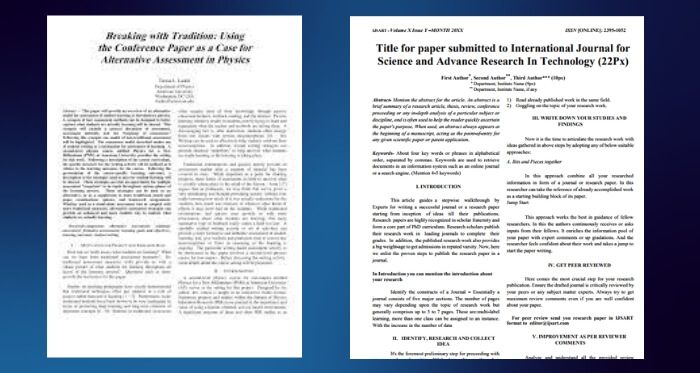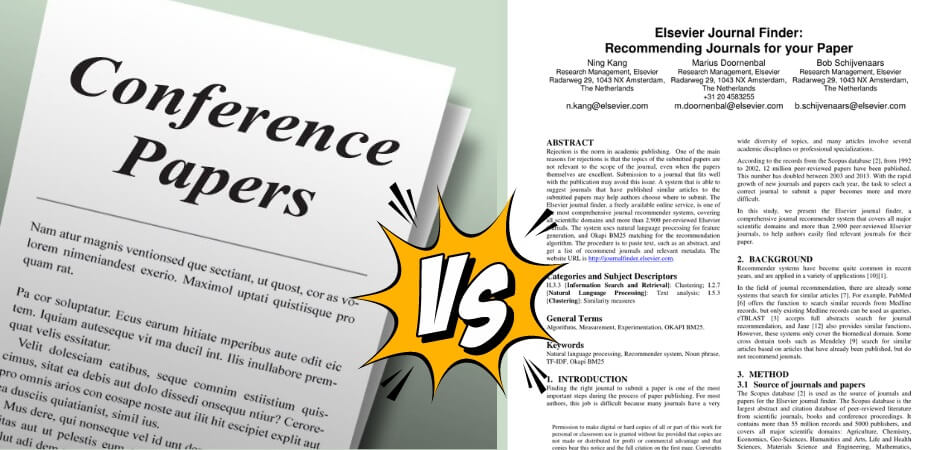In academia, disseminating one’s findings is as crucial as conducting the research. While there are various avenues to share knowledge, two prominent ways are through journals and conferences. Here, we delve into the nuanced world of conference paper vs journal paper.
At a glance, the primary distinction lies in the presentation; journal papers are crafted for publication in scholarly journals, while conference papers are destined for presentation at academic gatherings, possibly making their way into conference proceedings.
This subtle yet significant difference caters to diverse audiences and purposes, each with its unique set of standards and expectations. As we unfold the layers, the contrasting attributes between a conference paper and a journal paper offer a fascinating glimpse into the scholarly communication system.
A Brief Overview of Conference and Journal Papers
In academic circles, disseminating research findings significantly propels the boundaries of knowledge. Two prominent channels for this dissemination are conference and journal papers. Each avenue serves a distinct purpose, catering to different facets of the academic community.
Embarking on the journey of academic writing, one initially encounters the world of conference papers. These pieces serve as a platform for researchers to present their preliminary findings, receiving immediate feedback from peers. The dynamic setting of a conference fosters networking and collaborative opportunities, aiding in the refinement of the research.
On the other hand, journal papers represent a more formal and rigorous avenue of distribution. They undergo a stringent peer-review process, ensuring the research is high quality before publication. The published journal findings contribute to the existing body of knowledge, showcasing well-rounded and thoroughly vetted research.
Conference Paper Vs Journal Paper- What are the Differences?
Embarking on the academic publication journey unveils various paths, each with its unique merits and considerations. Two noteworthy paths are conference and journal papers, which cater to different stages and facets of scholarly communication. As we navigate the distinct characteristics, we understand their significance within the academic ecosystem more deeply.
Purpose and Scope
Conference papers often serve as a preliminary platform for researchers to unveil their findings. They present an avenue for receiving early feedback, enabling refinements before a more formal publication. This stage is crucial for developing research bolstering its evolution with peer insights.
In contrast, journal papers signify a more mature stage of research. They provide a platform for presenting well-rounded, thoroughly vetted findings. Their publication indicates a significant contribution to the existing body of knowledge, showcasing high scholarly rigor.
Peer Review Process
The peer review process in conferences is generally quicker, albeit less rigorous. It provides a swift pathway for researchers to share and discuss their findings. The emphasis here is on fostering discussions and collaboration.
Journal papers undergo a stringent and often lengthy peer review process. This rigorous scrutiny ensures the integrity and quality of the research. The process refines the paper to meet high academic standards, contributing to the paper’s robustness.
Publication Speed
Conference papers offer a faster route to publication, usually within a few months. This quick turnaround is beneficial for researchers keen on sharing emerging findings. It creates a vibrant, dynamic dialogue among the academic community.
Journal papers, on the other hand, have a longer gestation period, often extending over several months to a year. This prolonged timeline ensures thorough examination and validation of the research. It contributes to the high credibility associated with journal publications.
Networking and Collaboration
Conferences provide an excellent platform for networking and forging collaborative ties. Presenting a paper here facilitates immediate interaction with peers and experts. Such engagements often spawn new research ideas and partnerships.
Journal publications, while prestigious, lack the immediate interpersonal interaction seen in conferences. They offer a more formalized, structured medium of communication. The engagement here is often through citations and correspondence post-publication.
Audience and Reach
The conference audience is often more focused, comprising individuals interested in a particular field or topic. This narrowed audience can provide specialized feedback, enriching the research. It’s a conducive environment for targeted discussions and feedback.
Journal papers reach a broader academic audience, extending beyond the immediate circles of a conference. They serve as a lasting scholarly record accessible to researchers worldwide. This broad reach enhances the paper’s impact and the propagation of knowledge within and beyond the academic community.
The choice between a conference paper and a journal paper is nuanced hinged on various factors, including the research stage, the need for feedback, and the targeted audience. Both avenues carry unique advantages and considerations, forming the bedrock of academic discourse and advancement. Each path, while distinct, is instrumental in the vibrant tapestry of scholarly communication, contributing significantly to the collective endeavor of knowledge advancement and dissemination.
Pros and Cons of Using Conference Papers
Conference papers are an integral part of academic discourse, offering a platform for researchers to share and discuss preliminary findings. These papers foster a dynamic environment where immediate feedback and collaboration are encouraged. However, like any other medium, they come with their unique set of advantages and limitations.
Pros:
- Immediate Feedback: Presenting research at conferences provides instant feedback, further refining the study.
- Networking Opportunities: Conferences are fertile grounds for networking and establishing collaborations with other researchers.
- Professional Development: They offer a platform for researchers to improve their presentation and communication skills.
- Increased Visibility: Early exposure to research findings can attract attention from peers and potential collaborators.
- Discussion and Debate: The interactive setting fosters lively discussions, helping to view the research from different perspectives.
- Speedy Publication: Conference papers have a quicker publication than journal papers.
- Learning Experience: Exposure to various research topics and methodologies enhances the learning experience.
Cons:
- Less Rigorous Review: The review process is often less stringent, which may overlook certain flaws in the research.
- Temporary Visibility: The visibility might be temporary as conference papers may not be widely circulated post-conference.
- Limited Audience: Often limited to attendees, restricting the reach of the research.
- Less Prestigious: Generally considered less prestigious compared to peer-reviewed journal publications.
- Lack of Detailed Feedback: The feedback, although immediate, might need to be more detailed and comprehensive.
The journey of conference papers from conception to presentation is filled with opportunities for personal and professional growth despite certain limitations. Choosing this path can be particularly fruitful for emerging researchers, aiding in sculpting their future academic endeavors.
Pros and Cons of Using Journal Papers
Journal papers, often viewed as the crown jewels of academic publishing, offer an avenue for in-depth scholarly discourse. These meticulously reviewed publications are a testament to the rigor and quality of the research presented. However, the path of journal publication has its challenges, and understanding these facets aids in informed decision-making.
Pros:
- Rigorous Review: Journal papers undergo thorough peer review, ensuring high quality and integrity of research.
- Lasting Record: They are a permanent scholarly record accessible to researchers and scholars globally.
- Prestige and Credibility: Publishing in reputable journals boosts the credibility and recognition of the researcher’s work.
- Wide Reach: The research gains a broader audience, transcending the confines of conference attendees.
- Structured Feedback: Reviewer feedback is often detailed constructive, and aids in refining the research.
- Potential for Citations: Published journal papers often receive more citations, enhancing academic impact.
- Interdisciplinary Exposure: Journals might cater to diverse audiences, allowing cross-disciplinary exposure and collaboration.
Cons:
- Lengthy Review Process: A journal paper often takes several months to over a year to get published.
- High Rejection Rate: Many journals have a high rejection rate, making the publication process competitive.
- Limited Immediate Interaction: Conferences can limit immediate feedback due to a lack of direct interaction with peers.
- Cost Implications: Some journals charge publication fees, which might be a barrier for some researchers.
- Static Feedback Loop: Once published, any errors or oversights become part of the permanent record, unlike dynamic conference discussions.
Journal papers undoubtedly offer a gold standard for academic contributions, providing a platform that ensures the robustness and longevity of the research. The journey, although rigorous, can be enriching, solidifying one’s place in the academic landscape.
Final Considerations
The discourse around “conference paper vs journal paper” mirrors the dynamic and diverse landscape of academic publishing. Each avenue, with its unique set of attributes, significantly contributes to the scholarly ecosystem.
While conference papers offer a lively, immediate platform for feedback and discussions, journal papers provide a rigorously vetted, lasting record of academic contribution.
Choosing between these two depends greatly on the researcher’s objectives, the stage of the research, and the level of engagement with the academic community. As researchers navigate through these avenues, they weave the intricate tapestry of academic discourse, propelling the frontiers of knowledge ever forward.







